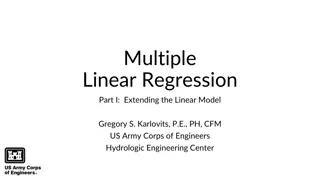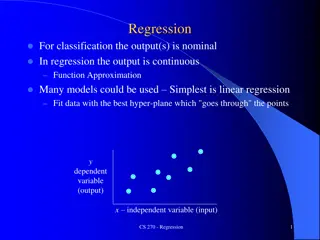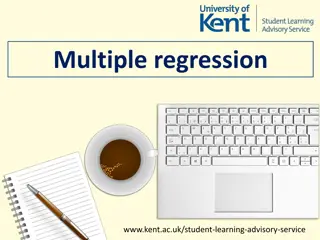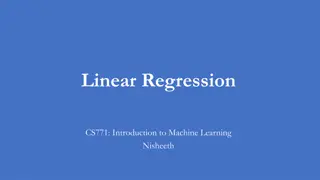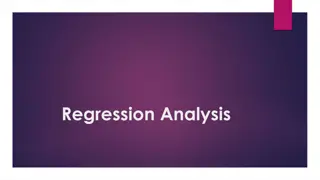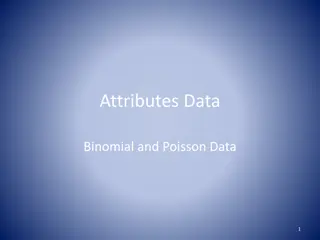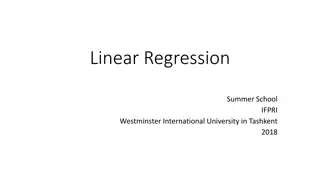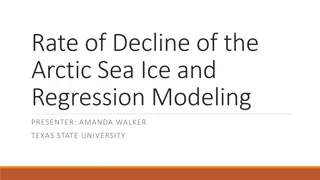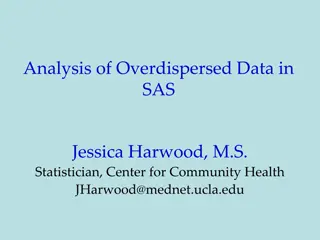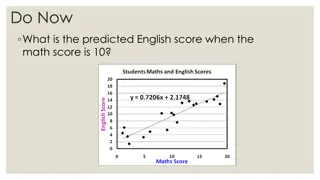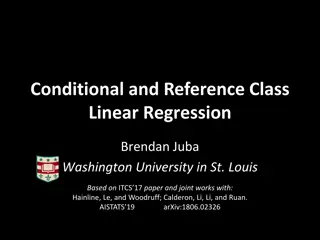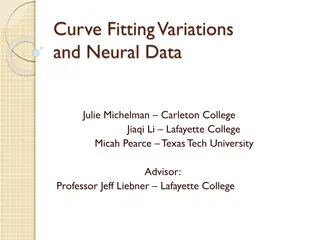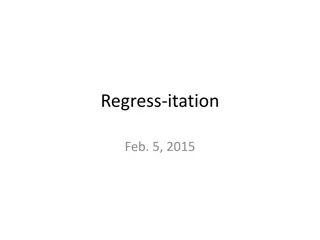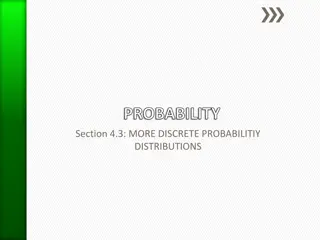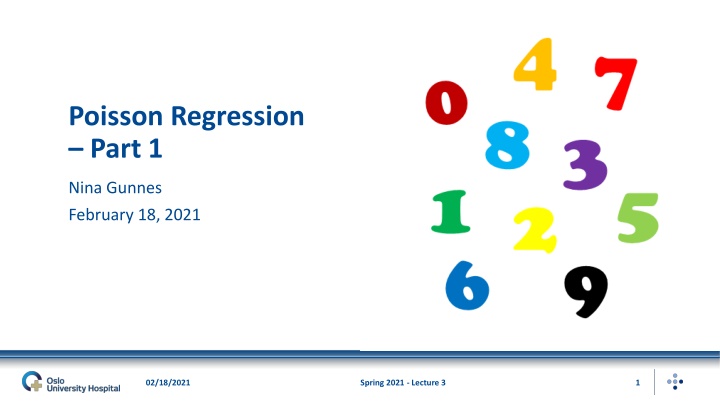
Poisson Regression and Distribution in Medical Applications
Explore the application of Poisson regression and distribution in medical scenarios, analyzing data of discrete observations like cases of melanoma or stroke deaths. Delve into the Poisson distribution, its approximation to the binomial, and its relevance in studying rare events and incidence rates. Gain insights into key concepts like expected values, variance, and disease occurrence measurement.
Download Presentation

Please find below an Image/Link to download the presentation.
The content on the website is provided AS IS for your information and personal use only. It may not be sold, licensed, or shared on other websites without obtaining consent from the author. If you encounter any issues during the download, it is possible that the publisher has removed the file from their server.
You are allowed to download the files provided on this website for personal or commercial use, subject to the condition that they are used lawfully. All files are the property of their respective owners.
The content on the website is provided AS IS for your information and personal use only. It may not be sold, licensed, or shared on other websites without obtaining consent from the author.
E N D
Presentation Transcript
Poisson Regression Part 1 Nina Gunnes February 18, 2021 02/18/2021 Spring 2021 - Lecture 3 1
Count data Discrete data Observations taking non-negative integer values 0,1,2, Integers arising from counting number of events Number of cases of malignant melanoma during follow-up Number of deaths due to a stroke during follow-up Often involving the binominal distribution or Poisson distribution Important analysis in medical applications 02/18/2021 Spring 2021 - Lecture 3 2
Count data, cont. Table 3.1 in Laake et al. (2007) 02/18/2021 Spring 2021 - Lecture 3 3
Poisson distribution Named after the French mathematician S. D. Poisson (1781 1840) Commonly used to describe rare events in a large population Probability distribution: ? ? = ? =?? ?: number of cases ?: expected number of cases Expected value equal to the variance E ? = ? = Var ? ?!? ?for ? = 0,1,2, 02/18/2021 Spring 2021 - Lecture 3 4
Poisson approximation to the binomial Binomial distribution approximated by the Poisson distribution ?~Bin ?,? Poi ? Expected number of events: E ? = ? = ?? ?: Number of trials (subjects) ?: probability of event Two key assumptions for the approximation to be valid Large number of trials (subjects): ? 50 Low probability of event: ? 0.05 02/18/2021 Spring 2021 - Lecture 3 5
Incidence rate Poisson distribution relevant for rare events Number of events small compared to total number of subjects E.g., number of deaths due to a heart attack during 10 years in a cohort study Defining the number of events during a period of time: ? Defining the total person-time at risk: ? Sum of all individual times from inclusion to either event or censoring Censoring resulting in event not observed during follow-up Due to withdrawal, emigration, death, end of study, etc. 02/18/2021 Spring 2021 - Lecture 3 6
Incidence rate, cont. Defining the incidence rate (measure of disease occurrence): ? Estimated by ? = ? ? Assuming ? follows a Poisson distribution with parameter ? = ?? Expected value: E ? = ? = ?? Variance: Var ? = ? = ?? Comparing incidence rates of disease between exposure groups Outcome variable: ? = ? ? Expected value of outcome variable: E ? = E ? ? = ?? ? = ? 02/18/2021 Spring 2021 - Lecture 3 7
Incidence rate, cont. ? ? ? 02/18/2021 Spring 2021 - Lecture 3 8
Poisson regression Disease occurrence dependent on exposure variables Incidence rate given the exposure variables: ? ?1,?2, ,?? Modeling relation between incidence rate and exposure variables Outcome variable: ? = ? ? Expected value of outcome variable: E ?|?1,?2, ,?? = ? ?1,?2, ,?? General formula: ? ?1,?2, ,?? = ??0+?1?1+?2?2+ +???? ?: number of exposure variables ? s: regression coefficients (effects of exposure variables on incidence rate) 02/18/2021 Spring 2021 - Lecture 3 9
Poisson regression, cont. Expressing formula as a generalized linear model (GLM) GLM: ln? ?1,?2, ,?? = ?0+ ?1?1+ ?2?2+ + ???? Link function (log link): ? ? = ln?, where ? = ? ?1,?2, ,?? Giving an alternative formulation of the GLM ln? ?|?1,?2, ,?? = ln? + ?0+ ?1?1+ ?2?2+ + ???? ln?: offset Aiming to estimate the regression coefficients Interpretation of ??through ???, where ? = 1,2, ,? 02/18/2021 Spring 2021 - Lecture 3 10
Poisson regression, cont. Table 10.1 in Aalen et al. (2006) 02/18/2021 Spring 2021 - Lecture 3 11
Incidence rate ratio Ratio between two incidence rates Interpreted as a relative risk Poisson regression giving estimated incidence rate ratio Interpretation of results depending on the nature of exposure variables Assuming a multiple Poisson regression model Dichotomous exposure variable: ?1(1 exposed, 0 unexposed) Continuous exposure variable: ?2 Incidence rate: ? = ??0+?1?1+?2?2 02/18/2021 Spring 2021 - Lecture 3 12
Incidence rate ratio, cont. Comparing incidence rates for two groups differing on ?1 Holding ?2constant Defining the incidence rates Reference group: ??1=0= ??0+?1 0+?2?2= ??0+?2?2 Exposure group: ??1=1= ??0+?1 1+?2?2= ??0+?1+?2?2 Calculating the incidence rate ratio ??1=1 ??1=0=??0+?1+?2?2 = ??0+?1+?2?2 ?0 ?2?2= ??1 ??? = ??0+?2?2 02/18/2021 Spring 2021 - Lecture 3 13
Incidence rate ratio, cont. Comparing incidence rates for two groups differing on ?2by one unit Holding ?1constant Defining the incidence rates Reference group: ??2=?2= ??0+?1?1+?2?2 Exposure group: ??2=?2+1= ??0+?1?1+?2?2+1 Calculating the incidence rate ratio ??2=?2+1 ??2=?2 =??0+?1?1+?2?2+1 ??0+?1?1+?2?2 = ??0+?1?1+?2?2+1 ?0 ?1?1 ?2?2= ??2 ??? = 02/18/2021 Spring 2021 - Lecture 3 14
Incidence rate ratio, cont. Value of the incidence rate ratio indicating reduced or increased risk ??? < 1: reduced risk ??? = 1: no difference in risk ??? > 1: increased risk 02/18/2021 Spring 2021 - Lecture 3 15
References Aalen OO, Frigessi A, Moger TA, Scheel I, Skovlund E, Veier d MB. Statistiske metoder i medisin og helsefag. Oslo: Gyldendal akademisk; 2006. Laake P, Hjart ker A, Thelle DS, Veier d MB. Epidemiologiske og kliniske forskningsmetoder. Oslo: Gyldendal akademisk; 2007. https://www.med.uio.no/imb/forskning/publikasjoner/boker/2007/e pidemiolgiske-kliniske-forskningsmetoder.html. 02/18/2021 Spring 2021 - Lecture 3 16

